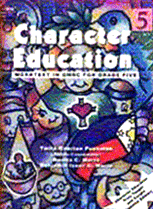|
Those who can--do. Those who can't--criticize. |
|
|
| |
|
| |
Activities | Integration | V.E. Articles | Tips for Teachers | Organizations | Profile| Contact Us
|
|
||||
|
his page is aimed at showing us that values development may be achieved through integration in the different subject areas. Find out the approaches in the integration of values and the strategies in the integration of values. Click On! | ||||
|
Strategies in Integration of Values Some of the most common and salient strategies in integrating values across levels are given below. These are used in the appropriate phases of learning. 1. Incomplete Sentence. This calls for the learners to complete a sentence or sentences that are related to the lesson. In using any of them, teachers should know that it could be done at the beginning of the lesson, at the middle portion, or at the end. By and large their main purpose is to draw responses from the learners that will reveal their choices, beliefs, opinions, preferences, attitudes, feelings, and the like. Examples: 1.1 The story is ______________________ (English) 1.2 Our lesson is _____________________ (General) 1.3 The experiment is __________________ (Science) 1.4 Solving fraction is __________________ (Mathematics) 1.5 Our school is ______________________ (General) After completing the sentence, the learners may be asked to explain further their answer. 2. Giving One’s Title a Poem/Story/Paragraph Read. Most often, teachers use poems and stories in their lesson in Communication Arts. Stories are also common materials in other subject areas. On the other hand, the use of paragraphs taken from books or magazines is more prevalent in all subjects. In such a case, the learners could be asked to give their own title. It could be done by groups or by individuals. The important thing though is to give them a chance to explain their choice for such title. 3. Using Value-Judgment Questions. This could be done at any phase of the lesson. This is the most common strategy because practically, this is part and parcel of teaching. Examples: a. If you were Rizal, would you have chosen to live rather than die? Why? (Social Studies) b. Do you think the chief character in the story is right in joining the rebel group? Why? (Communication Arts) c. What can you say about the action of Bonifacio in leaving the Tejeros Convention? Explain your answer. (Social Studies) d. Do you think Nobel had the right to invent the dynamite? Why? (Science) 4. Giving Caption to a Picture. Pictures are common visual aids among the teachers especially in the first two levels of education. It could be used in varied ways but it could also elicit valuing responses from the learners. A picture may be presented before them. Then they are grouped into five or more depending on the size of the class. Each group will be asked to give a title to the picture and to explain the choice for such. Group report will follow and afterwards the teacher may ask for other titles that were not given during the small group discussion. Emphasis should be placed on the reasons for choosing the title and the manner by which is was arrived at. 5. Values Voting. Here the teacher reads aloud in one by one questions which begin with: "How many of you ______________?" After each question is read, the learners take a stand by doing any of the following: a. Raising their hands (Affirmative) b. Pointing their thumbs down (Negative) c. Folding their arms (Undecided) d. Taking no action at all (Pass) The learners are then grouped according to their choices and then given opportunity to share and discuss the reasons for their stand. 6. Rank Order. This gives the learners the chance to choose among the alternatives and to discuss and defend their choices. Example: The following are the problems of our community. which is no. 1 to you? number 2, 3 and 4? _____ Cleanliness _____ Peace and Order _____ Lack of safe water to drink _____ Bad roads 7. Reacting to a Statement Made by a Person. (living, dead, character of a story) Examples: a. Ninoy Aquino said: "The Filipinos are worth dying for." What is your reaction? b. One landowner stated: "I defend my land. Nobody can get it from me." What can you say about the matter? 8. Judging the Activity Undertaken in Class. This could be done in all lessons where group activities are utilized. Emphasis should be laid on why a particular group was successful in their work and why a certain group failed in performing their task. Values such as cooperation, leadership, fellowship and the like may surface. 9. "I Learned" Statement. This strategy will provide the learners and the teacher feedbacks regarding the topic or activity they undertake. It clarifies and reinforces what the students have learned. Likewise, it crystallizes learning which many learners might not have realized. Likewise, it sets a good winding up for almost every activity undertaken. The procedure is simple. A chart is prepared by the teacher that could be posted prominently in the room at the end of the lesson. The following could be stems. 9.1 I learned that I _____________________________ 9.2 I discovered that I __________________________ 9.3 I realized that I _____________________________ Reference: Approaches and Strategies for Values Education by: | ||||
| Rebecca D. Alcantara, Dr. Camila C. Gonzales, Dr. Twila G. Punsalan, Susan S. dela Rosa, Dr. Juliet A. Gregorio, Dr. Jose Rizal G. Sanchez | ||||
| Approaches | |
| Strategies | |
| V.E. Integration Links | |
| Integration Main | |
 |
|
CE/GMRC for Grade 5 |
|
Home | Values Ed. Program |Approaches | Dimensions of Man | Sample Lessons Activities | Integration | V.E. Articles | Tips for Teachers | Organizations | Profile| Contact Us |
||||||||||
| ||||||||||
|
| ||||||||||
|
| ||||||||||
| ||||||||||